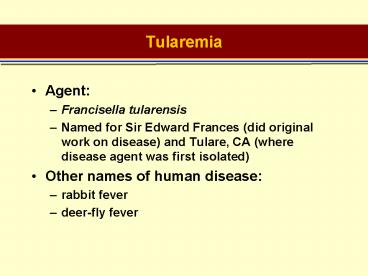Tularemia - PowerPoint PPT Presentation
1 / 20
Title:
Tularemia
Description:
may have multiple cutaneous lesions (musk-rat associated outbreak in Vermont) glandular (15-20%) like ulceroglandular without cutaneous lesions. oculoglandular (1-4 ... – PowerPoint PPT presentation
Number of Views:323
Avg rating:3.0/5.0
Title: Tularemia
1
Tularemia
- Agent
- Francisella tularensis
- Named for Sir Edward Frances (did original work
on disease) and Tulare, CA (where disease agent
was first isolated) - Other names of human disease
- rabbit fever
- deer-fly fever
2
Tularemia
- Microbiological features
- Gram-negative, coccobacillus
- non-motile, unencapsulated
- Two subtypes differ based on virulence
- Type A (biogroup tularensis)
- highly virulent for humans and rabbits
- found in North America
- Type B (biogroup palearctica)
- less virulent for humans, found in aqautic
animals - found in Asia and Europe
3
Tularemia
- Microbiological features
- no growth on routine media (requires cysteine or
cystine) - special culture media - thioglycolate,
glucose-cysteine blood agar, chocolate agar - addition of CO2 may enhance growth
4
Tularemia
- Pathogenesis
- intracellular growth, therefore cell-mediated
immunity directed against protein antigens is
responsible for resistance and recovery - infectious dose depends on site of entry
- few organisms (10-50) required for intradermal
injection or inhalation - large number (108) if ingested
5
Tularemia
- Epidemiology
- Occurrence
- common throughout North America
- more common in US prior to 1950, steadily
declining incidence since 1965 - Incidence 0.05-0.15/100,000
- 50 of cases from AR, OK, MO
- over 75 in men
- more common in gt30 years of age
- recent studies indicate pediatric population can
represent up to 28 of cases in certain areas
6
Tularemia
- Epidemiology
- Route of transmission
- bite of arthropod vector
- inoculation of skin, mucous membranes with
contaminated water, blood, tissue - ingestion of insufficiently cooked meat or
contaminated water - inhalation of dust from soil, grain, hay
- animal bite (rare) from animal eating on infected
carcass
7
Tularemia
- Vectors
- Amblyomma americanum - lone star tick
- Dermacentor variabilis - American dog tick
- D. andersoni - American wood tick
- Chrysops discalis - deer fly
- Aedes cinereus (Sweden)
8
Tularemia
- Clinical features
- Incubation period
- relates to virulence, size of inoculum, location
- 1 - 14 days (3-5 days average)
- Symptoms based on six classic forms of disease
- ulceroglandular
- glandular
- oculoglandular
- oropharyngeal
- typhoidal
- pneumonic
9
Tularemia
- Clinical features
- Symptoms
- abrupt onset of fever, chills, headache,
anorexia, fatigue - ulceroglandular (50-75)
- enlarging, painful lymphadenopathy
- large red papule that becomes ulcerative and
tender - may have multiple cutaneous lesions (musk-rat
associated outbreak in Vermont) - glandular (15-20)
- like ulceroglandular without cutaneous lesions
- oculoglandular (1-4)
- edematous, inflamed eyelid with ulceration of
conjunctiva and sclera
10
Tularemia
- Clinical features
- Symptoms
- oropharyngeal (4-18)
- pharyngitis ranging from mild to strep or
mono-like - local lymphadenopathy
- typhoidal (8-18)
- acute bacteremia
- skin manifestations (exanthems, erythema nodosum)
- diarrhea (bloody)
- pulmonary - infiltrates and pleural effusion can
be seen with other forms of disease
11
Tularemia
Lymphoglandular lesion - eschar
12
Tularemia
Lymphoglandular lesion - ulcer
13
Tularemia
Lymphoglandular lesion - necrotic lymph node
14
Tularemia
Typhoid form - x-ray of pulmonary inflitrates
15
Tularemia
Typhoid form - pulmonary inflitrates (CT scan)
16
Tularemia
Oculoglandular lesion
17
Tularemia
Lesions in liver from infected rabbit (white
spotted liver)
18
Tularemia
- Clinical features
- Diagnosis
- accurate history, with attention to epidemiologic
features - culture and identification
- type A ferment glycerol and converts citrulline
to ornithine - agglutination test - most commonly available
- can cross react with Brucella
- agglutinating antibodies with first couple of
weeks, peak in four weeks - a single titer gt1160 or four-fold rise in titer
- titers may remain elevated for 10 years
- PCR useful, but only available for research
purposes
19
Tularemia
- Clinical features
- Treatment
- streptomycin - drug of choice but limited supply
in some areas - gentamycin - when streptomycin not available
- doxycycline - 21 days preferred
- Case fatality ratio
- up to 60- inhaled form leading to pneumonia and
septicemia (typhoidal form) if untreated
20
Tularemia
- Prevention and control
- education
- avoid exposure
- proper handling during skinning, processing
protective gloves, eye wear - tick (and other arthropod) control
- proper cooking of meat
- live attenuated vaccines for certain occupations































